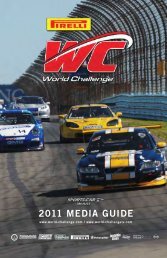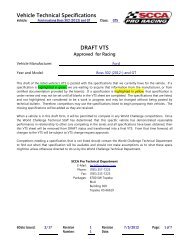built to conquer the greatest battle of all. your ... - World Challenge
built to conquer the greatest battle of all. your ... - World Challenge
built to conquer the greatest battle of all. your ... - World Challenge
Create successful ePaper yourself
Turn your PDF publications into a flip-book with our unique Google optimized e-Paper software.
The Series<br />
SCCA SPEED <strong>World</strong> Ch<strong>all</strong>enge Car Facts<br />
Classes<br />
Grand Touring (GT): The <strong>all</strong>owed body styles within this class are coupe, sedan and convertible.<br />
The cars permitted in GT are typic<strong>all</strong>y sold in <strong>the</strong> market as “sports” cars, “sport<strong>to</strong>uring”<br />
cars, or performance versions <strong>of</strong> “luxury” cars. Forced induction is permitted on cars<br />
that come equipped with forced induction s<strong>to</strong>ck, or on cars that SCCA Pro Racing has determined<br />
need help reaching <strong>the</strong> target horsepower range. Power output ranges from 425-525<br />
hp. Weight varies depending on power output and tire size. All <strong>of</strong> <strong>the</strong> vehicles in GT are rearwheel<br />
drive or <strong>all</strong>-wheel drive.<br />
Touring Car (TC): The <strong>all</strong>owed body styles in this class are coupes, hatchbacks, wagons or<br />
sedans. The cars permitted in TC are typic<strong>all</strong>y sold as “compact” cars, or “<strong>to</strong>uring” cars.<br />
Eligible cars must have realistic seating for four (4) adults. Power output ranges from 235 <strong>to</strong><br />
275 hp. Weight varies depending on <strong>the</strong> power output <strong>of</strong> <strong>the</strong> individual drivetrain configurations.<br />
Front-wheel, rear-wheel and <strong>all</strong>-wheel drive configurations are permitted. Forced<br />
induction may be <strong>all</strong>owed on cars that have forced induction systems available from <strong>the</strong> manufacturer<br />
which do not void <strong>the</strong> fac<strong>to</strong>ry warranties.<br />
Bodywork Modifications<br />
Bodywork Modifications: S<strong>to</strong>ck body panels may be lightened. Body panels must maintain<br />
s<strong>to</strong>ck pr<strong>of</strong>ile, unless alternate panel is approved. Non-essential trim may be removed.<br />
GT: Hood, trunk/decklid and doors may be aftermarket composite components. Vented hoods<br />
are approved on a car-by-car basis. Additional aftermarket composite components may be<br />
approved if deemed necessary <strong>to</strong> make a competitive package. Front splitter may protrude<br />
2” from approved front fascia, but may be no wider than <strong>the</strong> tires at <strong>the</strong>ir widest point.<br />
Splitter may deviate vertic<strong>all</strong>y on <strong>the</strong> sides and bot<strong>to</strong>m. Each car is permitted <strong>to</strong> run an<br />
approved rear wing.<br />
TC: Hood and trunk/decklid may be aftermarket composite components. Additional aftermarket<br />
composite components may be approved if deemed necessary <strong>to</strong> make a competitive<br />
package. Front splitter may protrude 1.5” from approved front fascia, but may be no wider<br />
than <strong>the</strong> tires at <strong>the</strong>ir widest point. Only rear wings approved for <strong>the</strong> Touring Car class are<br />
permitted. Wing is mounted at least 6” below ro<strong>of</strong>line, except for cars with a “wagon-type”<br />
body, which may not mount <strong>the</strong>ir wing more than 4” above <strong>the</strong> ro<strong>of</strong>line.<br />
Chassis Modifications<br />
Chassis Modifications: Interior may be removed except dashboard. Miscellaneous unused<br />
mounting brackets may be removed. Chassis seams may be welded. Windows may be<br />
replaced with Lexan. Doors must be capable <strong>of</strong> being opened from inside and outside. Driver’s<br />
seat may be moved rearward as long as <strong>the</strong> seat back at <strong>the</strong> driver’s shoulders does not pass<br />
<strong>the</strong> vertical plane <strong>of</strong> <strong>the</strong> rear seat shelf. Windshield wipers may be removed, but an operational<br />
mo<strong>to</strong>r must remain in place.<br />
GT: Minimum ride height is 3.0 inches.<br />
TC: Minimum ride height is 3.5 inches.<br />
Safety Modifications<br />
Safety Modifications: A full rollcage must be used. The rollcages typic<strong>all</strong>y have eight main<br />
attachment points within <strong>the</strong> cockpit/trunk, with additional tubes <strong>all</strong>owed <strong>to</strong> pass through <strong>the</strong><br />
firew<strong>all</strong>. The A-pillar, B-pillar, and ro<strong>of</strong> may be stitch welded <strong>to</strong> <strong>the</strong> rollcage. Fuel cells are<br />
30 2009 SCCA Pro Racing SPEED <strong>World</strong> Ch<strong>all</strong>enge Media Guide<br />
required, unless s<strong>to</strong>ck fuel tank is located between frame rails and <strong>the</strong> axles.<br />
The driver’s safety equipment includes a racing seat, six or seven-point harness, full-face helmet,<br />
head/neck restraint, window net, right-side head restraint net, side impact protection,<br />
driver leg support system, multi-layer suit, fire resistant shoes, gloves and underwear and a<br />
three-zone fire system.<br />
Engine Modifications<br />
Engine Modifications: Dry sump systems are permitted. Engines may be blueprinted and<br />
balanced. Full-prep engines may replace reciprocating internals. Cus<strong>to</strong>m intake manifolds<br />
may be <strong>all</strong>owed if deemed necessary. Engine management systems are free. Ignition system<br />
components may be replaced. Must maintain an operational on-board starter.<br />
GT: Forced induction is permitted and may be added <strong>to</strong> a car if deemed necessary <strong>to</strong> be a<br />
competitive package. Noise limit is 120 dBA. Traction control, and o<strong>the</strong>r commonly available<br />
electronic driver aids, are permitted.<br />
TC: Noise limit is 110 dBA. Electronic driver aids are not permitted.<br />
Drivetrain Modifications<br />
Drivetrain Modifications: Transmission and differential coolers may be added. Limited-slip<br />
differentials are permitted. One set <strong>of</strong> gear ratios and two final drive ratios, or equivalent, are<br />
permitted. If <strong>the</strong> approved set <strong>of</strong> gear ratios is o<strong>the</strong>r than <strong>the</strong> s<strong>to</strong>ck set, <strong>the</strong> s<strong>to</strong>ck set <strong>of</strong> ratios<br />
may also be used. Clutch design is free. Flywheel weight is free, but must be steel or aluminum,<br />
and ring gear diameter must be s<strong>to</strong>ck. Driveshafts and halfshafts may be modified<br />
or replaced, but must be same material and type as OEM. Alternate transmissions may be<br />
approved on a car-by-car basis if deemed necessary. Carbon clutches are permitted in GT<br />
only.<br />
Suspension Modifications<br />
Suspension Modifications: The OEM-type <strong>of</strong> suspension must be retained (i.e. McPherson<br />
Strut, double A-arm, etc.). Alternate control arms may be submitted for approval. Shocks and<br />
springs are free, but must remain in s<strong>to</strong>ck location. Anti-sway bars are free. Bushings are<br />
free. Steering geometry may be modified <strong>to</strong> correct bump steer.<br />
GT: The suspension pick-up points below <strong>the</strong> <strong>to</strong>p <strong>of</strong> <strong>the</strong> tire may be relocated 25mm, and <strong>the</strong><br />
suspension pick-up points above <strong>the</strong> tire may be relocated 75mm.<br />
Brake System Modifications<br />
Brake System Modifications: All <strong>World</strong> Ch<strong>all</strong>enge cars may replace <strong>the</strong> OEM brake system<br />
components with racing components. Carbon and Ceramic ro<strong>to</strong>rs are not permitted unless<br />
s<strong>to</strong>ck OEM components are being used.<br />
GT: The maximum ro<strong>to</strong>r size in GT is 380 mm x 30 mm minimum thickness front and 25 mm<br />
minimum thickness rear. The OEM caliper, any 4-pis<strong>to</strong>n caliper, or approved 6-pis<strong>to</strong>n calipers<br />
may be used. Water may be injected in<strong>to</strong> <strong>the</strong> brake ducts. ABS is permitted<br />
TC: The maximum ro<strong>to</strong>r size in TC is 328 mm x 25 mm minimum thickness front and 6mm<br />
minimum thickness rear. The OEM caliper or any 4-pis<strong>to</strong>n caliper may be used. ABS is not<br />
permitted. Water may only be injected in<strong>to</strong> <strong>the</strong> brake ducts on temporary street circuits.<br />
2009 SCCA Pro Racing SPEED <strong>World</strong> Ch<strong>all</strong>enge Media Guide 31<br />
The Series




